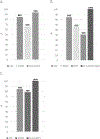Susceptibility of endometrial isolates recovered from women with clinical pelvic inflammatory disease or histological endometritis to antimicrobial agents
- PMID: 30753898
- PMCID: PMC6559736
- DOI: 10.1016/j.anaerobe.2019.02.005
Susceptibility of endometrial isolates recovered from women with clinical pelvic inflammatory disease or histological endometritis to antimicrobial agents
Abstract
The CDC recommended outpatient treatment of pelvic inflammatory disease (PID) is an intramuscular dose of ceftriaxone plus 14 days of doxycycline, with or without metronidazole. European guidelines (2017) include moxifloxacin plus ceftriaxone as a first line regimen, particularly for women with Mycoplasma genitalium-associated PID. However, the susceptibility of bacteria recovered from the endometrium of women with PID to moxifloxacin is unknown. The in vitro antibiotic susceptibility of facultative and anaerobic bacteria recovered from endometrial biopsy samples were evaluated from 105 women having symptomatic PID and/or histologically confirmed endometritis. A total of 342 endometrial isolates from enrollment visits were identified using a combination of biochemical tests and sequencing. Isolates were tested for antimicrobial susceptibility using agar dilution against ceftriaxone, clindamycin, doxycycline, metronidazole and moxifloxacin according to the Clinical and Laboratory Standards Institute (CLSI) guidelines. Neisseria gonorrhoeae was susceptible to ceftriaxone with all isolates having an MIC of 0.03 μg/mL. All the other endometrial isolates were susceptible to ceftriaxone, except for Prevotella species, only half of which were susceptible. The in vitro susceptibility profile for BV-associated bacteria (Gardnerella vaginalis, Atopobium vaginae, Prevotella species, Porphyromonas species and anaerobic gram-positive cocci) revealed greater susceptibility to moxifloxacin compared to doxycycline. Moxifloxacin was superior to metronidazole for G. vaginalis and A. vaginae, and either metronidazole or moxifloxacin was needed to cover Prevotella species. Based on in vitro susceptibility testing, the combination of ceftriaxone plus moxifloxacin provides similar coverage of facultative and anaerobic pathogens compared to the combination of ceftriaxone, metronidazole and doxycycline. Head to head clinical studies of these treatment regimens are needed to evaluate clinical efficacy and eradication of endometrial pathogens following treatment.
Keywords: Metronidazole; Minimal inhibitory concentration; Moxifloxacin; Pelvic inflammatory disease.
Copyright © 2019 Elsevier Ltd. All rights reserved.
Figures

Similar articles
-
A Randomized Controlled Trial of Ceftriaxone and Doxycycline, With or Without Metronidazole, for the Treatment of Acute Pelvic Inflammatory Disease.Clin Infect Dis. 2021 Apr 8;72(7):1181-1189. doi: 10.1093/cid/ciaa101. Clin Infect Dis. 2021. PMID: 32052831 Free PMC article. Clinical Trial.
-
Susceptibility of bacterial vaginosis (BV)-associated bacteria to secnidazole compared to metronidazole, tinidazole and clindamycin.Anaerobe. 2017 Oct;47:115-119. doi: 10.1016/j.anaerobe.2017.05.005. Epub 2017 May 15. Anaerobe. 2017. PMID: 28522362 Free PMC article.
-
Susceptibility of upper-genital tract isolates from women with pelvic inflammatory disease to ampicillin, cefpodoxime, metronidazole, and doxycycline.Sex Transm Dis. 1991 Jul-Sep;18(3):146-9. doi: 10.1097/00007435-199107000-00004. Sex Transm Dis. 1991. PMID: 1948511
-
The polymicrobial etiology of acute pelvic inflammatory disease and treatment regimens.Rev Infect Dis. 1985 Nov-Dec;7 Suppl 4:S696-702. doi: 10.1093/clinids/7.supplement_4.s696. Rev Infect Dis. 1985. PMID: 3909326 Review.
-
Infections in the female genital tract.Compr Ther. 1983 Aug;9(8):34-47. Compr Ther. 1983. PMID: 6413123 Review.
Cited by
-
Gardnerella vaginalis as a Cause of Bacterial Vaginosis: Appraisal of the Evidence From in vivo Models.Front Cell Infect Microbiol. 2020 Apr 24;10:168. doi: 10.3389/fcimb.2020.00168. eCollection 2020. Front Cell Infect Microbiol. 2020. PMID: 32391287 Free PMC article. Review.
-
Megasphaera lornae sp. nov., Megasphaera hutchinsoni sp. nov., and Megasphaera vaginalis sp. nov.: novel bacteria isolated from the female genital tract.Int J Syst Evol Microbiol. 2019 Jun;71(3):004702. doi: 10.1099/ijsem.0.004702. Epub 2021 Feb 22. Int J Syst Evol Microbiol. 2019. PMID: 33616513 Free PMC article.
-
Protease activities of vaginal Porphyromonas species disrupt coagulation and extracellular matrix in the cervicovaginal niche.NPJ Biofilms Microbiomes. 2022 Feb 21;8(1):8. doi: 10.1038/s41522-022-00270-7. NPJ Biofilms Microbiomes. 2022. PMID: 35190575 Free PMC article.
-
Antimicrobial Susceptibility Profile of Rare Anaerobic Bacteria.Antibiotics (Basel). 2022 Dec 29;12(1):63. doi: 10.3390/antibiotics12010063. Antibiotics (Basel). 2022. PMID: 36671264 Free PMC article.
-
Antimicrobial Resistance and Extended-Spectrum Beta-Lactamase Genes in Enterobacterales, Pseudomonas and Acinetobacter Isolates from the Uterus of Healthy Mares.Pathogens. 2023 Sep 8;12(9):1145. doi: 10.3390/pathogens12091145. Pathogens. 2023. PMID: 37764953 Free PMC article.
References
-
- Ness RB, Soper DE, Holley RL, et al. Effectiveness of inpatient and outpatient treatment strategies for women with pelvic inflammatory disease: results from the Pelvic Inflammatory Disease Evaluation and Clinical Health (PEACH) randomized trial. Am J Obstet Gynecol 2002; 186(5): 929–37. - PubMed
-
- Centers for Disease Control and Prevention. Sexually transmitted diseases treatment guidelines. MMWR 2015; 64(No.3): 69–72. - PubMed
-
- Ross J, Guaschino S, Cusini M, Jensen J. 2017 European guideline for the management of pelvic inflammatory disease. Inter J of STD & AIDS 2017; 0(0): 1–7. - PubMed
-
- Burnett AM, Anderson CP, Zwank MD. Laboratory-confirmed gonorrhea and/or chlamydia rates in clinically diagnosed pelvic inflammatory disease and cervicitis. Am J Emerg Med 2012; 30: 1114–7. - PubMed
MeSH terms
Substances
Grants and funding
LinkOut - more resources
Full Text Sources
Medical
Molecular Biology Databases

